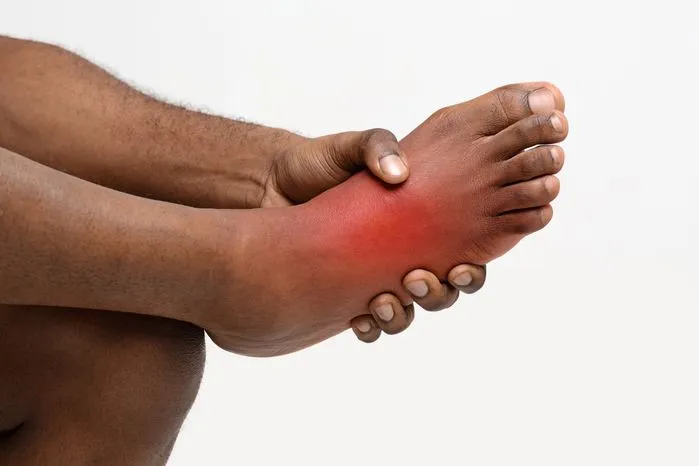
The foot fungus medical term refers to fungal infections of the feet that affect the outer layers of the skin, hair, and nails. Foot fungus may infect any part of the foot, but most often grows between the toes. The two common foot fungal infections are tinea pedis foot and onychomycosis.
Tinea pedis
Tinea pedis - commonly known as athlete’s foot - is a foot fungus infection that starts between the toes of the foot. It’s particularly common between the 4th and 5th toe space. If left untreated, this foot fungus can spread to the sole or other warm, moist parts of the body like the groin. You can also get foot fungus on heel of the foot. Tinea pedis sometimes leads to bacterial infections. Research shows that up to 70% of people will, at some point, develop foot fungus contagious infection.
Onychomycosis
Onychomycosis - the foot fungus medical term for nail fungus - is a toenail fungal infection that starts as a yellow or white spot under the toenail tip. As it progresses, this foot fungus toenail infection causes nail discoloration, thickening, and crumbling at the edge. Onychomycosis can affect one or several toenails especially, the big and little toenails. It often accompanies an athlete’s foot and is prevalent in people with a weakened immune system.
Causes Of Foot Fungus
Foot fungus infections are mostly caused by dermatophyte fungi such as Trichophyton rubrum, and T. interdigitale. These are fungi that depend on keratin for growth and can cause infections on the skin, hair, and nails. Jock itch and ringworm are often caused by the same fungi.
Dermatophytes exist harmlessly on human skin. As long as the skin is dry and clean, their production is limited. However, damp socks and shoes and warm, humid conditions encourage rapid multiplication. Other organisms that cause foot fungal infections include yeasts, such as Candida albicans, and molds, such as Scopulariopsis brevicaulis.
Risk Factors
Some of the risk factors for foot fungus include:
- Excessive sweating
- Damp or ill-fitting shoes, and footwear that covers the entire foot such as sports shoes, and boots.
- Underlying conditions such as diabetes or psoriasis
- Untreated fungal infections
- Hot and humid conditions
- Obesity
- Wearing socks with poor ventilation
- Prolonged exposure to water
- Certain sporting activities
Can Foot Fungus Spread?
Foot fungus mostly spreads through either direct or indirect contact. Direct contact occurs when an uninfected person touches the infected part, such as foot fungus blisters, of somebody with the fungus. Indirect contact involves using contaminated socks, shoes, bedsheets, towels, or contact with contaminated floors.
Foot Fungus Symptoms
The symptoms of both types of foot fungus include:
Tinea Pedis
- Itchy, dry, or scaly skin in between the toes or on the bottom of the foot
- Unpleasant smell
- Small to medium-sized foot fungus blisters on the inner part of the foot
- Inflamed skin that appears reddish, purplish, or grayish depending on skin color
- Burning or stinging sensation
Onychomycosis
- White or yellow streak with some scaling on one side of the nail
- White spots on the nail plate
- Slightly foul smell
- Nail discoloration and damage
- Nail thickening
- Distorted In shape
- A dark color caused by a buildup of debris under the nail.
Treatment For Foot Fungus
Foot fungus symptoms are usually mild and don’t require a doctor’s attention. Simple treatment at home mostly does the trick. However, It’s advised to see a doctor if the infection doesn’t improve after two weeks of self-treatment or the foot fungus blisters worsen. Diabetics should always consult a doctor if they suspect a foot fungus infection.
Home Remedies
At-home remedies include washing the skin around the nail and foot regularly with mild soap and water. Soaking the feet in saltwater or diluted vinegar will help clear up the foot fungus with blisters.
Some believe that soaking feet in tea tree oil is a great cure for foot fungus, but research on the same is limited. Some preventive measures such as keeping the feet dry at all times and wearing clean cotton socks also hasten the healing process.
There are OTC antifungal medications in pharmacies that are effective in foot fungus treatment. They are available as tablets, powders, creams, and sprays. Some topical creams such as clotrimazole and ketoconazole are recommended for the treatment of mild infections.
Most of the symptoms of foot fungus toenail infection are mild and will not require any treatment. Self-care tips and medications may help if the infection is painful and has caused thickened nails. A study found that using mentholated ointments like Vicks VapoRub for onychomycosis treatment showed a positive effect in 83% of participants.
Doctor’s Treatment For Foot Fungus
Foot fungus diagnosis mostly involves observation of the symptoms. However, a doctor may want to rule out other conditions such as psoriasis and dermatitis before commencing foot fungus treatment. The doctor may recommend oral medication such as fluconazole and terbinafine if topical therapy fails. The AAD endorses antifungal pills as a better and faster treatment for foot fungus than topical creams.
Sometimes in severe nail fungus infections, medication doesn’t work. The doctor may opt to remove the entire nail either surgically or chemically. The nail will grow back with both treatment options. Scientists have experimented with the use of lasers as a cure for foot fungus. However, even though the procedure has proved safe, it may cause pain and bleeding.
Conclusion
Foot fungi are widespread. Follow the recommended preventive measures such as always keeping your feet dry, wearing breathable shoes and sweat-absorbent socks, and practicing good feet hygiene. Any abnormal changes to the skin or nails should be reported to a medical professional for proper treatment.

















